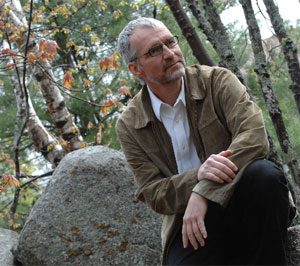 |
| Brian Noble is a co-investigator with the project, Intellectual Property Issues in Cultural Heritage: Theory, Practice, Policy, Ethics. (Danny Abriel Photo) |
In the opening moments of Raiders of the Lost Ark, Indiana Jones manages to retrieve a priceless indigenous relic from a South American temple, but not without leaving a trail of destruction in his wake.
Real experts in cultural heritage acknowledge the movie franchise is over-the-top entertainment, presenting a cartoon version of archaeology as death-defying adventure. And even though Indy preaches good science to his students (not to mention Harrison Ford’s recent election to the Archaeological Institute of America), they can’t help but shudder at his scant regard for the indigenous peoples who have claim to the treasures he takes.
As Indy’s fourth adventure hits the big screen, an international team of archaeologists, anthropologists, museum specialists, ethicists and lawyers is pondering the ethical and legal issues surrounding cultural heritage, with a particular emphasis on the archaeological record.
“We have to understand that material carries knowledge that comes from indigenous, local and descendant peoples,” says Brian Noble, a co-investigator on the project and professor with the Department of Sociology and Social Anthropology at Dalhousie University. “We have to work harder at engaging communities in a way that is not about dominating, but rather respects their rights and practices. This means getting beyond the presumption that heritage is merely there for the taking.”
|
“Concerns about intellectual property in cultural heritage are not limited to Indigenous peoples (although they have been the most affected)," says Dr. Nicholas, an archaeologist. "There are scientists taking each other to court over access to the results of research on the Dead Sea Scrolls, for example, as well as questions about the appropriateness of using an image of Tollund Man, an extraordinarily well-preserved 'bog body' from Denmark, used to sell facial cream."
Dr. Nicholas co-developed the project with Julie Hollowell, a cultural anthropologist from Indiana University, and Kelly Bannister, an ethnobotanist from the University of Victoria. More than 50 researchers from nine Canadian universities are involved, as well as from universities in Australia, the United States, New Zealand, South Africa, Germany, England and Finland.
Partnering groups include the World Intellectual Property Organization (Geneva), Parks Canada, the Canadian Archaeological Association, and more than a dozen First Nations, from the Sto:lo in the Fraser Valley to the Barunga of northern Australia.
In recent decades, questions about who “owns” or has the right to benefit from the past have emerged as highly contentious issues in archaeology and related disciplines. Some recent examples:
- The Snuneymuxw First Nation of British Columbia registered 10 ancient petroglyphs as official marks with the Canadian Intellectual Property Office to prevent them from being copied and reproduced;
- The U.S. government was forced to reject the Hagahai patent after widespread outrage. The aborted patent No. 5,397,696 was an attempt at ownership of the disease-resistant blood cells of the Hagahai, a tribe of hunter-gatherers from Papua, New Guinea;
- The discovery of a well-preserved corpse high in Alps—the “Iceman”—has incited a battle by officials in Italy, Austria and Switzerland over whom he belongs to.
In contrast to the controversy over the Iceman, Dr. Noble says a Canadian case of a young aboriginal hunter whose body was discovered in a retreating glacier is an interesting example of what can happen when different players—First Nations peoples, forensic scientists, anthropologists, museum curators—work together. Soon after the discovery in 1999, the British Columbia government and Champagne and Aishihik First Nations came to an agreement over how the remains and associated artifacts would be handled and studied.
|
Lawrence Joe, heritage director with the Champagne and Aishihik First Nations, told CBC News they were interested in what scientists might find out and if that would coincide with traditional knowledge: “We want to be able to use the science to confirm our cultural knowledge, our beliefs and our family relationships.”
Kwaday Dan Ts'inchi’s remains were cremated and his ashes scattered over the glacier where he died. Researchers determined he was in his late teens or early 20s and wore a woven, cedar-bark hat and a robe made from gopher or squirrel skins and stitched together with sinew. He carried a walking stick, an iron-blade knife and a spear. Questions remains about where he was traveling to and what caused his death.
“What happens when you have this complex of players?” says Dr. Noble. “In this case, the players came up with a protocol and were able to collaborate. In the process, the Champagne and Aishihik were able to assert greater autonomy over their heritage.”
About to embark on a sabbatical, Dr. Noble will be developing community case studies for the project involving the Piikani (Peigan) Blackfoot of southern Alberta and the Secwepmc people of south-central British Columbia. In particular, he will look at how these peoples have reclaimed laws and practices in relation to their cultural heritage as the means for building proper relations with researchers from beyond their communities.
